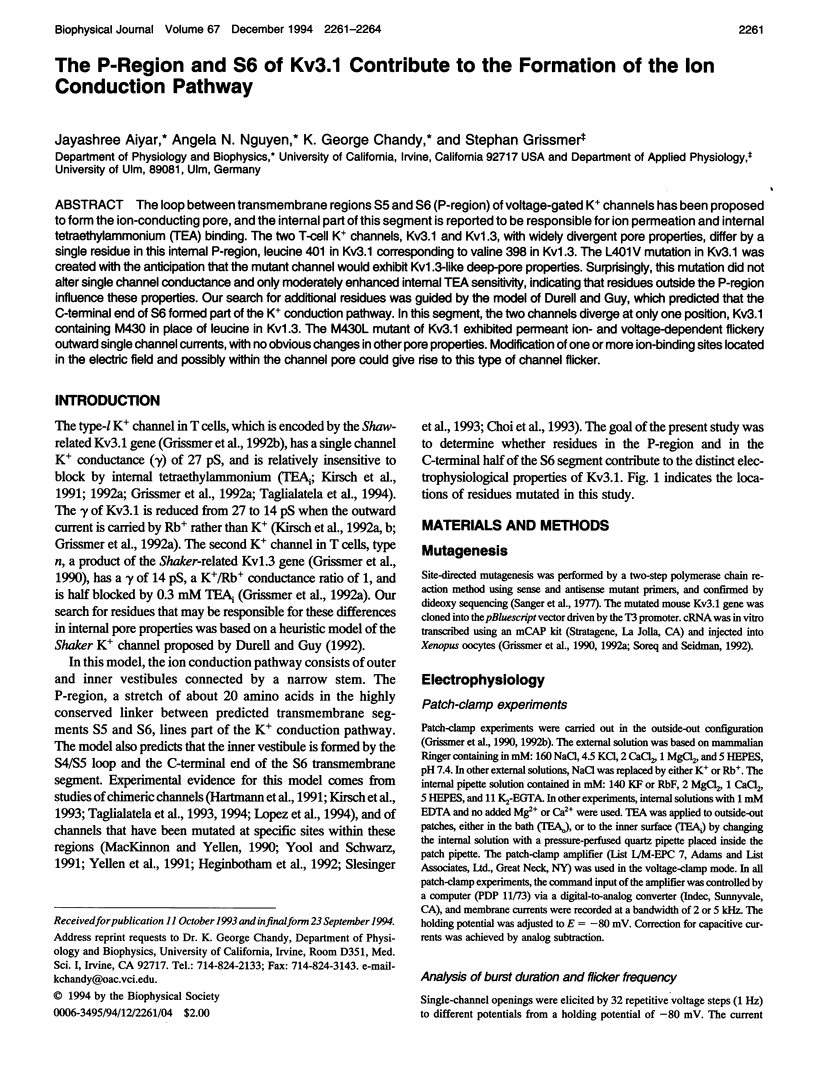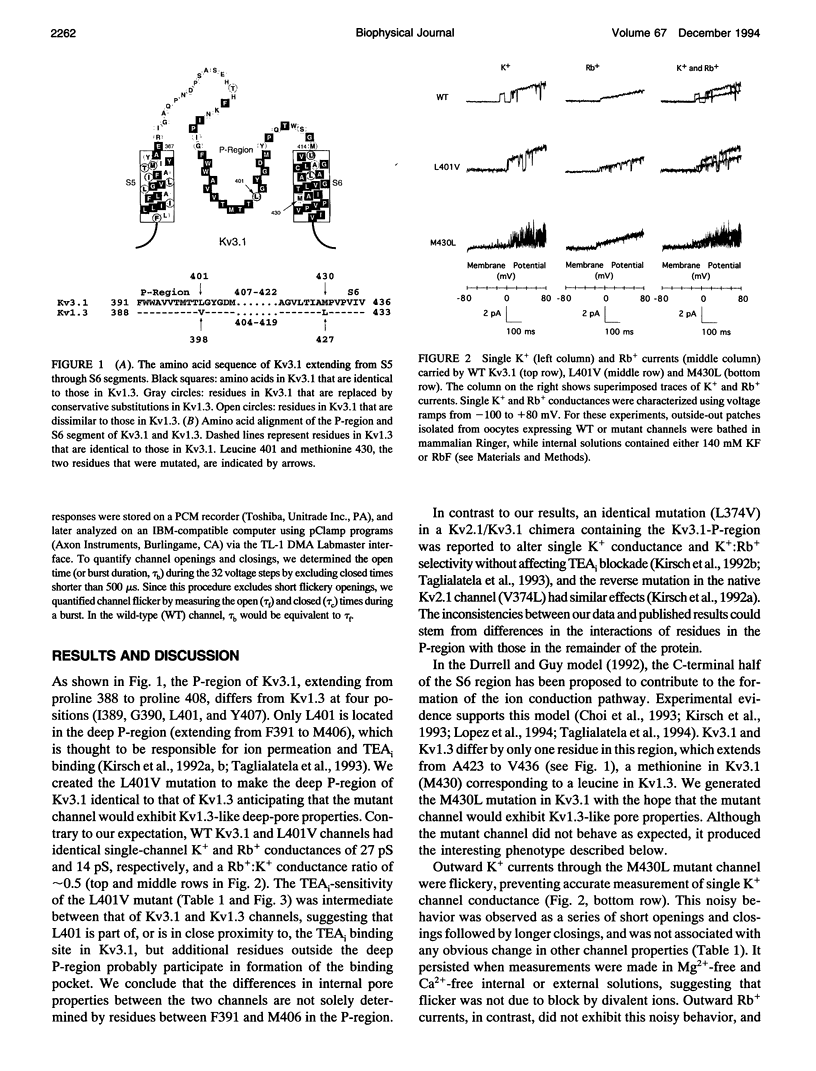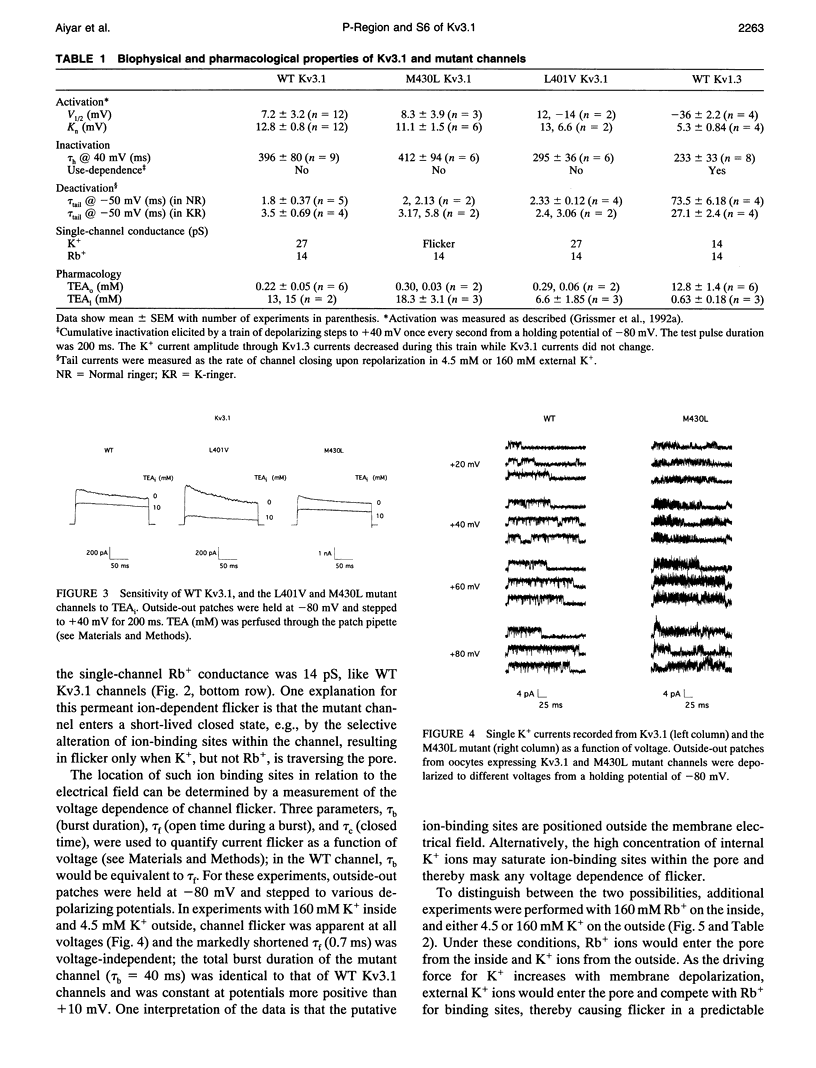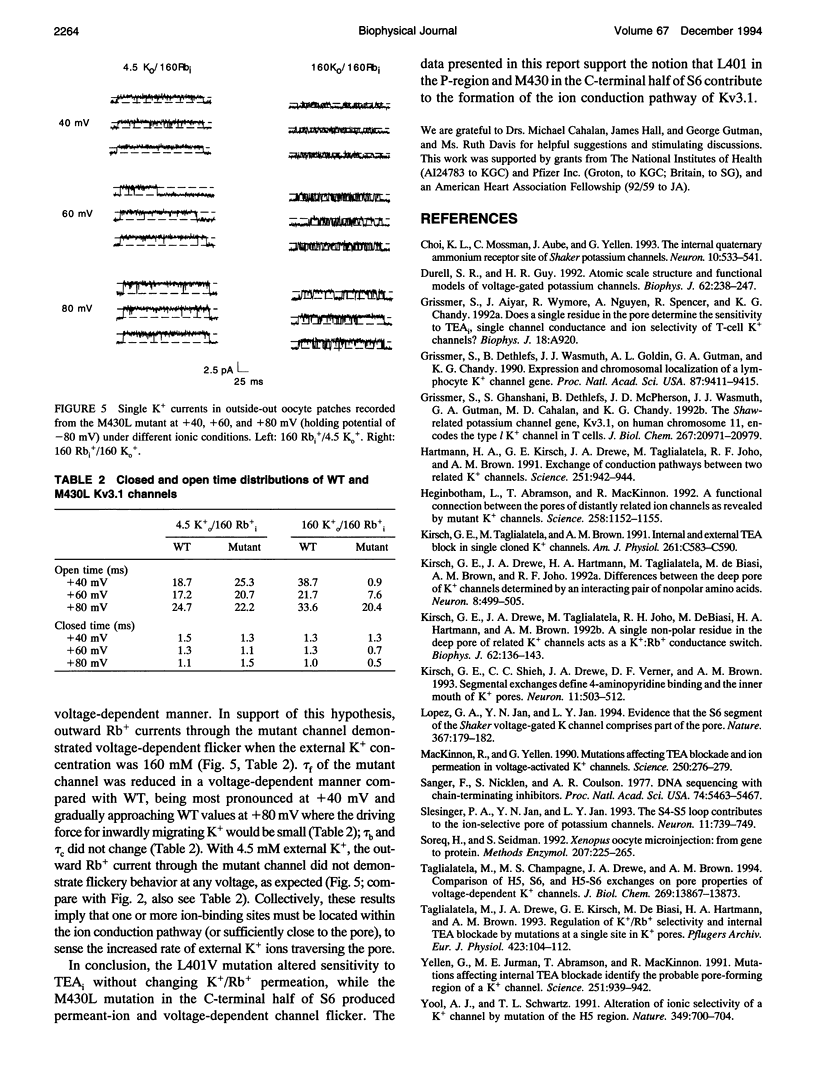Abstract
The loop between transmembrane regions S5 and S6 (P-region) of voltage-gated K+ channels has been proposed to form the ion-conducting pore, and the internal part of this segment is reported to be responsible for ion permeation and internal tetraethylammonium (TEA) binding. The two T-cell K+ channels, Kv3.1 and Kv1.3, with widely divergent pore properties, differ by a single residue in this internal P-region, leucine 401 in Kv3.1 corresponding to valine 398 in Kv1.3. The L401V mutation in Kv3.1 was created with the anticipation that the mutant channel would exhibit Kv1.3-like deep-pore properties. Surprisingly, this mutation did not alter single channel conductance and only moderately enhanced internal TEA sensitivity, indicating that residues outside the P-region influence these properties. Our search for additional residues was guided by the model of Durell and Guy, which predicted that the C-terminal end of S6 formed part of the K+ conduction pathway. In this segment, the two channels diverge at only one position, Kv3.1 containing M430 in place of leucine in Kv1.3. The M430L mutant of Kv3.1 exhibited permeant ion- and voltage-dependent flickery outward single channel currents, with no obvious changes in other pore properties. Modification of one or more ion-binding sites located in the electric field and possibly within the channel pore could give rise to this type of channel flicker.
Full text
PDF



Images in this article
Selected References
These references are in PubMed. This may not be the complete list of references from this article.
- Choi K. L., Mossman C., Aubé J., Yellen G. The internal quaternary ammonium receptor site of Shaker potassium channels. Neuron. 1993 Mar;10(3):533–541. doi: 10.1016/0896-6273(93)90340-w. [DOI] [PubMed] [Google Scholar]
- Durell S. R., Guy H. R. Atomic scale structure and functional models of voltage-gated potassium channels. Biophys J. 1992 Apr;62(1):238–250. doi: 10.1016/S0006-3495(92)81809-X. [DOI] [PMC free article] [PubMed] [Google Scholar]
- Grissmer S., Dethlefs B., Wasmuth J. J., Goldin A. L., Gutman G. A., Cahalan M. D., Chandy K. G. Expression and chromosomal localization of a lymphocyte K+ channel gene. Proc Natl Acad Sci U S A. 1990 Dec;87(23):9411–9415. doi: 10.1073/pnas.87.23.9411. [DOI] [PMC free article] [PubMed] [Google Scholar]
- Grissmer S., Ghanshani S., Dethlefs B., McPherson J. D., Wasmuth J. J., Gutman G. A., Cahalan M. D., Chandy K. G. The Shaw-related potassium channel gene, Kv3.1, on human chromosome 11, encodes the type l K+ channel in T cells. J Biol Chem. 1992 Oct 15;267(29):20971–20979. [PubMed] [Google Scholar]
- Hartmann H. A., Kirsch G. E., Drewe J. A., Taglialatela M., Joho R. H., Brown A. M. Exchange of conduction pathways between two related K+ channels. Science. 1991 Feb 22;251(4996):942–944. doi: 10.1126/science.2000495. [DOI] [PubMed] [Google Scholar]
- Heginbotham L., Abramson T., MacKinnon R. A functional connection between the pores of distantly related ion channels as revealed by mutant K+ channels. Science. 1992 Nov 13;258(5085):1152–1155. doi: 10.1126/science.1279807. [DOI] [PubMed] [Google Scholar]
- Kirsch G. E., Drewe J. A., Hartmann H. A., Taglialatela M., de Biasi M., Brown A. M., Joho R. H. Differences between the deep pores of K+ channels determined by an interacting pair of nonpolar amino acids. Neuron. 1992 Mar;8(3):499–505. doi: 10.1016/0896-6273(92)90278-l. [DOI] [PubMed] [Google Scholar]
- Kirsch G. E., Drewe J. A., Taglialatela M., Joho R. H., DeBiasi M., Hartmann H. A., Brown A. M. A single nonpolar residue in the deep pore of related K+ channels acts as a K+:Rb+ conductance switch. Biophys J. 1992 Apr;62(1):136–144. doi: 10.1016/S0006-3495(92)81800-3. [DOI] [PMC free article] [PubMed] [Google Scholar]
- Kirsch G. E., Shieh C. C., Drewe J. A., Vener D. F., Brown A. M. Segmental exchanges define 4-aminopyridine binding and the inner mouth of K+ pores. Neuron. 1993 Sep;11(3):503–512. doi: 10.1016/0896-6273(93)90154-j. [DOI] [PubMed] [Google Scholar]
- Kirsch G. E., Taglialatela M., Brown A. M. Internal and external TEA block in single cloned K+ channels. Am J Physiol. 1991 Oct;261(4 Pt 1):C583–C590. doi: 10.1152/ajpcell.1991.261.4.C583. [DOI] [PubMed] [Google Scholar]
- Lopez G. A., Jan Y. N., Jan L. Y. Evidence that the S6 segment of the Shaker voltage-gated K+ channel comprises part of the pore. Nature. 1994 Jan 13;367(6459):179–182. doi: 10.1038/367179a0. [DOI] [PubMed] [Google Scholar]
- MacKinnon R., Yellen G. Mutations affecting TEA blockade and ion permeation in voltage-activated K+ channels. Science. 1990 Oct 12;250(4978):276–279. doi: 10.1126/science.2218530. [DOI] [PubMed] [Google Scholar]
- Sanger F., Nicklen S., Coulson A. R. DNA sequencing with chain-terminating inhibitors. Proc Natl Acad Sci U S A. 1977 Dec;74(12):5463–5467. doi: 10.1073/pnas.74.12.5463. [DOI] [PMC free article] [PubMed] [Google Scholar]
- Slesinger P. A., Jan Y. N., Jan L. Y. The S4-S5 loop contributes to the ion-selective pore of potassium channels. Neuron. 1993 Oct;11(4):739–749. doi: 10.1016/0896-6273(93)90083-4. [DOI] [PubMed] [Google Scholar]
- Soreq H., Seidman S. Xenopus oocyte microinjection: from gene to protein. Methods Enzymol. 1992;207:225–265. doi: 10.1016/0076-6879(92)07016-h. [DOI] [PubMed] [Google Scholar]
- Taglialatela M., Champagne M. S., Drewe J. A., Brown A. M. Comparison of H5, S6, and H5-S6 exchanges on pore properties of voltage-dependent K+ channels. J Biol Chem. 1994 May 13;269(19):13867–13873. [PubMed] [Google Scholar]
- Taglialatela M., Drewe J. A., Kirsch G. E., De Biasi M., Hartmann H. A., Brown A. M. Regulation of K+/Rb+ selectivity and internal TEA blockade by mutations at a single site in K+ pores. Pflugers Arch. 1993 Apr;423(1-2):104–112. doi: 10.1007/BF00374967. [DOI] [PubMed] [Google Scholar]
- Yellen G., Jurman M. E., Abramson T., MacKinnon R. Mutations affecting internal TEA blockade identify the probable pore-forming region of a K+ channel. Science. 1991 Feb 22;251(4996):939–942. doi: 10.1126/science.2000494. [DOI] [PubMed] [Google Scholar]
- Yool A. J., Schwarz T. L. Alteration of ionic selectivity of a K+ channel by mutation of the H5 region. Nature. 1991 Feb 21;349(6311):700–704. doi: 10.1038/349700a0. [DOI] [PubMed] [Google Scholar]



